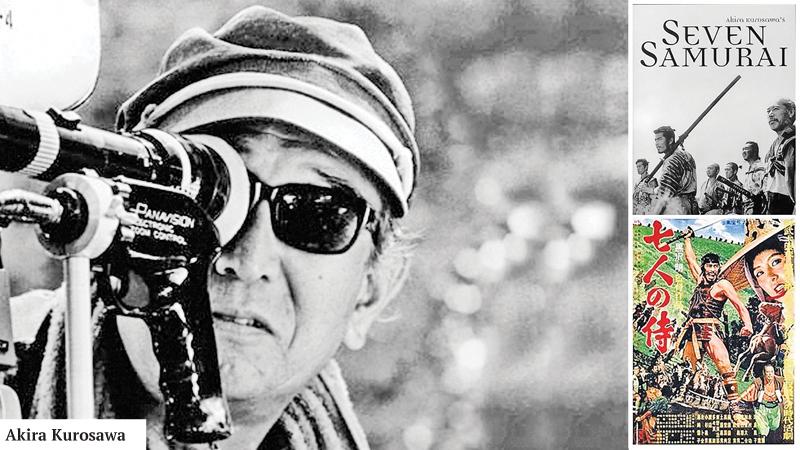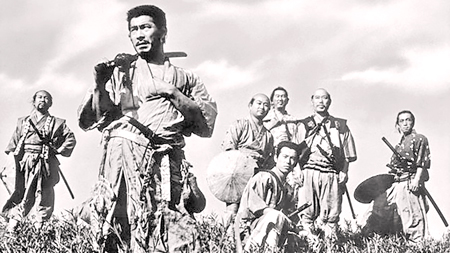
Seven Samurai is a 1954 Japanese epic samurai drama film co-written, edited, and directed by Akira Kurosawa. The story takes place in 1586 during the Sengoku period of Japanese history. It follows the story of a village of desperate farmers who hire seven rōnin (masterless samurai) to combat bandits who will return after the harvest to steal their crops.
At the time, the film was the most expensive film made in Japan. It took a year to shoot and faced many difficulties. It was the second-highest grossing domestic film in Japan in 1954. Many reviews compared the film to westerns.
Since its release, ’Seven Samurai’ has consistently ranked highly in critics’ lists of the greatest films, such as the BFI’s ’Sight & Sound’ and ‘Rotten Tomatoes’ polls. It was also voted the greatest foreign-language film in BBC’s 2018 international critics’ poll. It has remained highly influential, often seen as one of the most “remade, reworked, referenced” films in cinema.
Writing
Akira Kurosawa had originally wanted to direct a film about a single day in the life of a samurai. Later, in the course of his research, he discovered a story about samurai defending farmers. According to actor Toshiro Mifune, the film was originally going to be called ’Six Samurai’, with Mifune playing the role of Kyuzo.
 During the six-week scriptwriting process, Kurosawa and his screenwriters realized that “six sober samurai were a bore — they needed a character that was more off-the-wall”. Kurosawa recast Mifune as Kikuchiyo and gave him creative licence to improvise actions in his performance. During the six-week scriptwriting process, the screenwriters were not allowed visitors or phone calls.
During the six-week scriptwriting process, Kurosawa and his screenwriters realized that “six sober samurai were a bore — they needed a character that was more off-the-wall”. Kurosawa recast Mifune as Kikuchiyo and gave him creative licence to improvise actions in his performance. During the six-week scriptwriting process, the screenwriters were not allowed visitors or phone calls.
Kurosawa and the writers were innovative in refining the theme of the assembly of heroic characters to perform a mission. According to Michael Jeck’s DVD commentary, ’Seven Samurai’ was among the first films to use the now-common plot element of the recruiting and gathering of heroes into a team to accomplish a specific goal, a device used in later films such as ’The Guns of Navarone’, ’Sholay’, the western remake ’The Magnificent Seven’, and Pixar’s animated film ’A Bug’s Life’.
Film critic Roger Ebert speculates in his review that the sequence introducing the leader Kambei (in which the samurai shaves off his topknot, a sign of honor among samurai, in order to pose as a monk to rescue a boy from a kidnapper) could be the origin of the practice, now common in action movies, of introducing the main hero with an undertaking unrelated to the main plot. Other plot devices such as the reluctant hero, romance between a local woman and the youngest hero, and the nervousness of the common citizenry, had appeared in other films before this but were combined in this film.
Set design
Kurosawa refused to shoot the peasant village at Toho Studios and had a complete set constructed at Tagata on the Izu Peninsula, Shizuoka. Although the studio protested the increased production costs, Kurosawa was adamant that “the quality of the set influences the quality of the actors’ performances... “For this reason, I have the sets made exactly like the real thing. It restricts the shooting but encourages that feeling of authenticity.” He also spoke of ‘intense labour’ of making the film: “It rained all the time, we didn’t have enough horses. It was just the kind of picture that is impossible to make in this country.”
Filming
Long before it was released, the film had already become a topic of wide discussion. After three months of pre-production it had 148 shooting days spread out over a year — four times the span covered in the original budget, which eventually came to almost half a million dollars. Toho Studios closed down production at least twice. Each time, Kurosawa calmly went fishing, reasoning that the studio had already heavily invested in the production and would allow him to complete the picture. The film’s final battle scene, originally scheduled to be shot at the end of summer, was shot in February in near-freezing temperatures. Mifune later recalled that he had never been so cold in his life.
Through the creative freedom provided by the studio, Kurosawa made use of telephoto lenses, which were rare in 1954, as well as multiple cameras which allowed the action to fill the screen and place the audience right in the middle of it. “If I had filmed it in the traditional shot-by-shot method, there was no guarantee that any action could be repeated in exactly the same way twice.”
He found it to be very effective and he later used it in movies that were less action-oriented. His method was to put one camera in the most orthodox shooting position, another camera for quick shots and a third camera “as a kind of guerrilla unit”. This method made for very complicated shoots, for which Kurosawa choreographed the movement of all three cameras by using diagrams.
The martial arts choreography for the film was led by Yoshio Sugino of the Tenshin Shōden Katori Shintō-ryū. Initially Junzo Sasamori of the Ono-ha Itto-ryu was working along with Sugino, but he was asked by the Ministry of Education to teach in Europe during production.
Release
At 207 minutes, including a five-minute intermission with music, ’Seven Samurai’ would be the longest picture of Kurosawa’s career. Fearing that American audiences would be unwilling to sit through the entire picture, Toho Studios originally removed 50 minutes from the film for US distribution. Similar edits were distributed around the world until the 1990s. Since then the complete version is usually seen.
